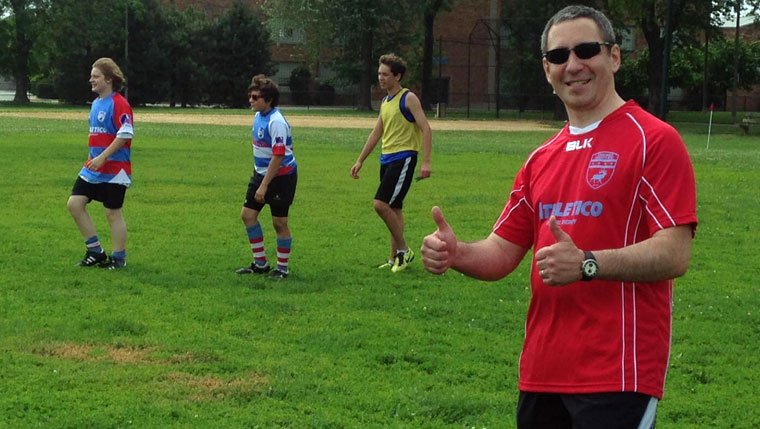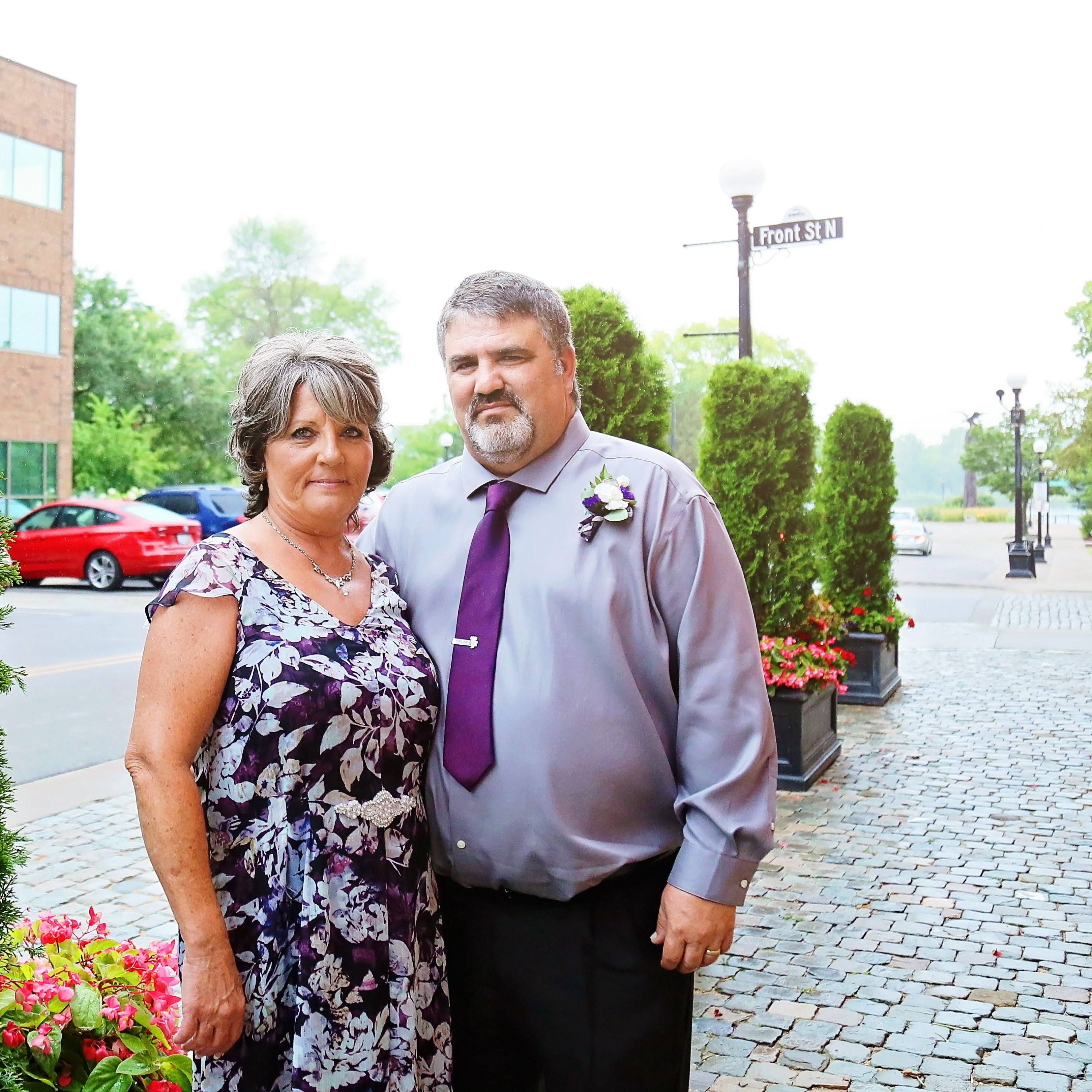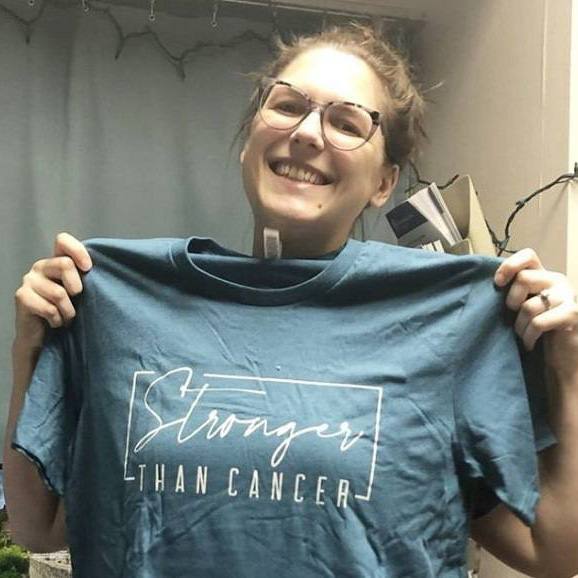At age 39, Tom Peroulas was active and fit. Coaching and playing rugby, biking to work in downtown Chicago, and exercising daily kept him in good shape. So when he started noticing pain in his leg, groin and hip, he thought it was probably related to activity. He tried stretching and yoga. He rested it. He worked with a physical therapist. Nothing helped.
After several months of persistent pain, Tom turned to his doctor, who referred him to a specialist in orthopedics. By the time he turned 40, in April 2013, tests revealed the startling reason for his discomfort: an uncommon kind of cancer called chondrosarcoma that begins in the cartilage around bones. The cancer was affecting Tom's hip socket, or acetabulum. But although the source of the pain had become clear, the best way to deal with it had not.
Faced with a wide range of surgical options, Tom dove into researching his choices. After an exhaustive search that had him talking with physicians as far away as Canada and Europe, he decided to go to Mayo Clinic. Using a unique technique for hip reconstruction, the orthopedic surgery Tom had at Mayo allowed him to return to his life with the cancer removed and chances good that he won't need another reconstruction in the future.
"I spoke with many of the most respected names in orthopedics and oncology," Tom says. "Ultimately, I chose Mayo Clinic for their unique plan, team approach, and experience with this rare procedure."
Facing a complex problem
Chondrosarcoma can be hard to manage when it affects bones in the upper femur and hip. Getting all the cancer often calls for taking out the hip joint along with part of the pelvic bone — a surgery known as partial hemipelvectomy. That was the case for Tom. Finding a way to then reconstruct the bones so the leg can still function has long been a challenge for orthopedic surgeons.
In fact, until about 20 years ago, saving a person's leg after surgery for chondrosarcoma in the pelvic region often wasn't an option at all. A complete hemipelvectomy with leg amputation was frequently a result of the surgery. Fortunately, that's no longer the case.
As Tom found in his research, a variety of choices are now available after partial hemipelvectomy. They include using cadaver bone to take the place of the missing bone, having a metal prosthesis made to fit the space where the bone is removed, and surgically fixing the remaining bones in place. One option, called a flail hip, allows for no reconstruction. The leg bone is left to heal unattached in the hip pocket.
"I'm forever grateful that I had this surgery at Mayo Clinic. The careful planning of my care, the collaboration, the quality of care, it was all excellent."
Over the last five years, however, surgeons at Mayo Clinic have been exploring a new alternative that appears to offer a better solution. Franklin Sim, M.D., is a Mayo Clinic orthopedic surgeon who often works with people that have chondrosarcoma. Dr. Sim saw the success his colleague David Lewallen, M.D., had in pioneering a new type of total hip replacement. The implant used in the replacement is made of a metal called tantalum that is foam-like and sometimes referred to as highly porous metal. Once placed in the body, bone grows into and around the implant so, essentially, it becomes part of a person's skeleton.
"People who have a failed total hip replacement come in with problems similar to those of people who have tumors, such as poor bone quality and big bone defects," says Dr. Sim. "The new technology using porous tantalum has met with a great deal of success for that first group. With that in mind, we've adopted the same technique for people who need hip and pelvic reconstruction after removal of a tumor."
Relying on a team approach
After carefully considering all his options, Tom opted to go with the surgery and reconstruction proposed by Dr. Sim and his team.
"I went to Mayo Clinic with my wife to do some research in person," Tom says. "They were clearly at the leading edge of the surgery. They took us through a comprehensive presentation that showed what they used to do versus what they do now. I asked a lot of detailed questions. When we drove away that day, my wife and I knew what we had to do."
"One of the things that impressed me the most about Mayo Clinic was the collaboration. Three surgeons were involved in my surgery ... I was able to count on subspecialists to tackle the complexities. That was all part of the process."
Tom underwent the 16-hour surgery at Mayo Clinic in July 2013. It included removing a large portion of the left side of his pelvis, as well as the upper end of his femur. Tom's hip was reconstructed with a tantalum metal implant that included an artificial hip to replace the joint and upper end of the femur. The reconstruction made the leg and hip stable and ensured that both legs would be the same length after surgery.
"One of the things that impressed me the most about Mayo Clinic was the collaboration," says Tom. "Three surgeons were involved in my surgery: one to take out the bone with the tumor, another to do the reconstruction, and a third to close it all up. I was able to count on subspecialists to tackle the complexities. That was all part of the process. I appreciated that approach."
Looking forward with confidence
After surgery was over, Tom began the long process of recovery. Three months in, he faced a serious setback when he acquired an infection in his leg that required another surgery to effectively treat it.
By November, however, Tom progressed to walking with one crutch. By January 2014, he returned to work. Using a cane, he was able to take public transportation and walk a half-mile to and from the train for his commute. In April, he returned to coaching youth rugby.
"I still use a cane when I'm out in the community for safety and awareness," he says. "Around the office and home, I don't. My gait is a little wobbly, but it continues to level off."
Because porous metal implants in people with chondrosarcoma are still relatively new, there's no long-term data available for that specific use of the technology yet. For hip replacements, though, more than a decade of use has shown that it is uncommon for people to need another surgery to replace the tantalum implants. That's different from the other surgical approaches, which may fail over time and require additional reconstruction.
"As long as there is enough of the pelvic bone left to fix the implant securely in place, new bone will grow into it," says Dr. Sim. "Once that happens, reconstruction should be permanent and offer solid stability and function. Although the technology will continue to evolve, the early results look very good."
As Tom considers the future, he knows challenges still exist. Dealing with chronic lymphedema as a result of his surgery, as well as needing lifelong antibiotics in an effort to prevent another infection are daily reminders that complications are not uncommon. Regular follow-up tests to check for cancer recurrence are also now part of his standard medical care. But as he takes stock of what he's been through, he is confident in the decisions he made.
"I'm forever grateful that I had this surgery at Mayo Clinic. The careful planning, the collaboration, the quality of care, it was all excellent," he says. "It is a long road, and not enough can be said for the support of family, friends and peers. For those facing a difficult diagnosis, I would encourage exploring the options available to you. Still, much of the disease process is out of our control. Through the relationships I have made in the relatively small chondrosarcoma community, I have come to appreciate the unique and very personal circumstances that shape our cancer experience. I am humbled by each and every journey."
HELPFUL LINKS
- Learn more about cancer treatment at Mayo Clinic.
- Learn more about orthopedic surgery at Mayo.
- Join a discussion about cancer on Mayo Clinic Connect.
- Request an appointment.









